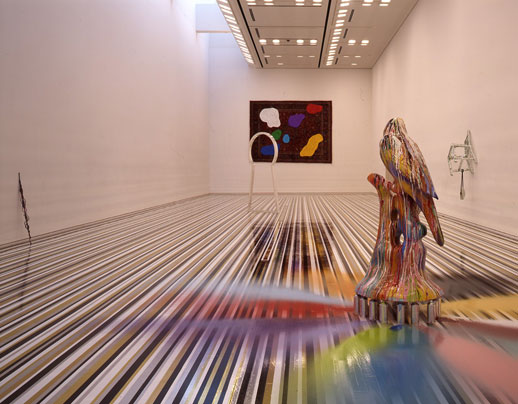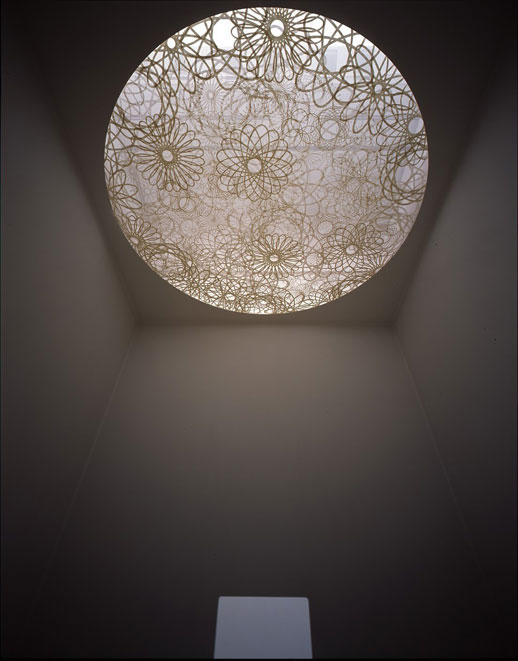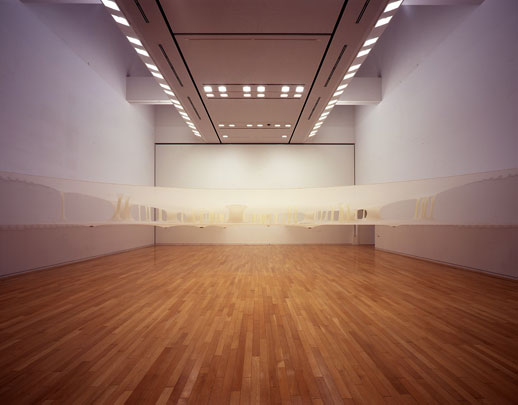Tripolar Disorder?
When this writer was a small baby, too helpless to take to his own feet and explore this world, his thoughtful parents had an idea. They bought a toy designed to stimulate his senses and placed it in his cot. It was a colourful piece of kit with plenty of baubles, windows that opened and many different textures: scratchy, fluffy, smooth and so on. The centrepiece was a plastic mirror so that baby D would come to know the fact of his own existence. I suppose this is all true but I don’t remember anything of it now.
28 years later and the same baby has cast aside his infantile obsession with colourful, attention-grabbing objects in order to become an art critic. Due to a confluence of factors too complex to describe here, he enters an exhibition called Melting Point at a leisure emporium called Opera City in the city of Tokyo, Japan.

Who’s this in the first room? It’s Scottish dean of pop art, Jim Lambie. What does he do? Visual overload, that’s what. Lambie’s laying down of stripes of reoccurring bright colours on the floor cites the confident Cool Britannia (Oh no! I said it!) of a Paul Smith shirt. No, let’s be honest: boxer briefs, aren’t they? Mirrors? Check. Novelties? Mirrored chair. Textures? So many I want to run my chubby infant mitts over each and every one, but this is a gallery and I mustn’t stick my hands out of the pram. Lambie’s creations are not just for babies though: for adults of a certain age who share his taste culture of retro rock-meets-disco hedonism, Lambie is pure Donna Summer bending over to fellate Jimi Hendrix while a stupendous joint cries Mary from the axe maestro’s hand and lights my fire on a paisley carpet spattered with the tragically young vomit of a choking Jim Morrison. Anyway, on a commercial note, Lambie’s visual perception jokes are guaranteed to pull in the crowds of intricacy-oriented Japanese art students who packed out the Super-Escher show in Tokyo last year. The floor lines are not just to (mis)guide you to the exit either; they link works that, viewed separately, are no more than conceptual half-puns and spin them into an inexplicably groovy whole. Incidentally, Lambie was doing something similar at the Mizuma Gallery in Nakameguro before that and Opera City have rather disingenuously used those images to promote this exhibition.

After Lambie’s rainbow rock-out, Kiyomichi Shibuya wants to show you the finer details. He wants to train your baby’s eye to notice the subtlest fluctuations of light and shape. Only works of the purest white are good enough to attest to light’s glory. Refute this colourific bombast of Lambie, he appears to be saying while waving his tiny scissors. Because, yes, Shibuya’s preferred medium is the paper doily. The doily! That useless piece of symmetrical trash that you took home to your mother in third grade and she had to pretend to like before ‘accidentally’ dropping it into the paper shredder while you were taking your bath and, here’s the thing, nobody could spot the difference afterwards! Of course I’m jesting. Kiyomichi Shibuya’s doilies and dainty doodles are the very epitome of Eastern philosophy and nature appreciation and I’ve just been infused with rock ‘n’ roll attitude by Jim Lambie’s carpet of vomit. In other words, I’m not convinced by the juxtaposition of these two artists.
So, is there a grand unifier in the house? Is there a third artist who will step up to the microphone and apply thematic lubrication to indifferent lovers who have thus far failed to conjoin? Who are you? Ernesto Neto. What do you do? I hang giant gauze condoms. Where? From ceilings mainly, but also from giant membranes stretched between walls. Is that easy? Well, I must fill my fabric sacks with objects such as pebbles or colourful pus to weigh them down. What’s the point? So that people might discover new ways of interacting in the unique spaces created by my enormous sheaths. Do you mean, like, pretend to be sperm? That’s up to people. Can I take a photo of my friend pretending to be a sperm? No, absolutely not.

To go back to my original metaphor, that of a sensory plaything for babies, the point is that each element stimulates differently but they needn’t make sense as a whole. Melting Point is a bit like that: a console of fun-looking elements that, when you examine them together, don’t really have anything to say. No real problem there. A pick ‘n’ mix, play-oriented exhibition like this one doesn’t need a strong message but it should display a readiness to hand the initiative to the ‘player’, the visitor. Opera City, like most Tokyo galleries, is institutionally incapable of doing this. Rules, ‘this way’ arrows and hushed silences abound. Happily, the ticket includes entry to the upstairs gallery and Soju Tao’s very playful ruminations on music stardom. At least someone was allowed to rock out.



